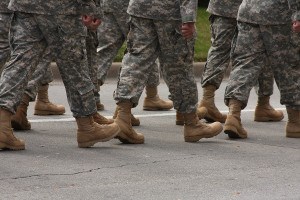Military service personnel who survive the hazards of war return to face new risks on domestic roadways, according to a study by USAA.
According to USAA’s “Returning Warriors” study, troops coming back from deployment had 13 percent more at-fault accidents within the first six months of returning when compared to the six months prior to deployment.
Enlisted ranks were more prone to such accidents than officers, and those in the Army and Marines had much higher crash rates than those in the Navy or Air Force.
Study highlights include:
- Enlisted personnel (E1-E4) had 22 percent more at-fault accidents, non-commissioned officers (E5-E9) 10 percent more and officers 3.5 percent more.
- Losing control of the vehicle was the most common cause of at-fault accidents.
- “Objects in the road” as the reported cause of accidents increased dramatically – more than any other cause.
- Younger (under 22) drivers’ crash rates were more than three times the crash rates for older drivers.
- Multiple deployments led to higher crash rates, and individuals with longer deployments were generally more likely to be involved in at-fault accidents.
“Our men and women in uniform put their lives on the line when they deploy in service of this country, but they can face new threats to their safety when they come home and get behind the wheel,” said retired U.S. Army Maj. Gen. Kevin Bergner, president of USAA Property and Casualty Insurance Group.
USAA conducted a study focusing on private passenger vehicle driving experiences of USAA-member military personnel over a three-year period, which included 171,000 deployments to various overseas locations.
Professor Erica Stern of the University of Minnesota has also studied the driving experiences of returning soldiers and has found “carryover” driving behaviors that may help explain some of this increase. Troops’ driving maneuvers were useful in deployment but may add risk on American roadways. For example, soldiers commonly describe driving at inappropriate speeds and reluctance to stop at intersections.
Driving behaviors potentially carried home from deployment:
- Reluctance to stop at intersections.
- Driving at inappropriate speeds (too fast or too slow).
- Changing lanes while traveling under bridges.
- Reluctance to use seatbelts.
- Driving in the center of roads.
Source: Erica Stern, PhD, OTR/L and USAA
Was this article valuable?
Here are more articles you may enjoy.


 J&J Talc Jury Awards $1.56 Billion to Asbestos Cancer Victim
J&J Talc Jury Awards $1.56 Billion to Asbestos Cancer Victim  Wells Fargo Sued by Ex-Manager Who Said Bank Faked Diversity
Wells Fargo Sued by Ex-Manager Who Said Bank Faked Diversity  Flooding in California Leads to Soaked Roads, Water Rescues and 1 Death
Flooding in California Leads to Soaked Roads, Water Rescues and 1 Death  Trump Sues BBC for $10 Billion Over Documentary Edit
Trump Sues BBC for $10 Billion Over Documentary Edit 